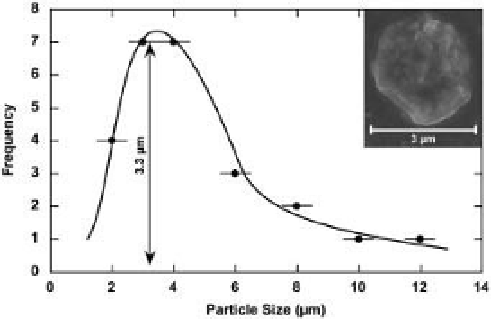Geology Reference
In-Depth Information
Rivers in China and found χ
ARM
/SIRM ratios of these
fl uvially derived sediments to be between 0.1 and
0.9 × 1 0
− 3
m/A. Kumar
et al
. (2005) conducted a rock
magnetic study of Arabian Sea sediments of the coast
of India, and found χ
ARM
/SIRM ratios from 1.0 to
2.0 × 1 0
− 3
m/A for early Holocene sediments consid-
ered to have been derived from predominately fl uvial
sources. It is then apparent that eolian-derived mag-
netic particles have χ
ARM
/SIRM ratios larger than that
of fl uvially derived particles. Since higher ratios indi-
cate a smaller magnetic particle size, this observation
is consistent with the grain size sorting expected due
to transport by wind compared to that by water. It also
shows the power of environmental magnetic parame-
ters to detect the source environment of sediments and
sedimentary rocks.
Loess, an eolian sediment derived from glacially
eroded material, has been shown to carry an impor-
tant environmental magnetic signal (e.g. see Evans &
Heller 2003). The loess plateau of central China is the
most important deposit of these sediments globally.
Glacial and interglacial periods are recorded by inter-
vals of weak and strong susceptibilities, respectively.
The record can be tied unequivocally to the oxygen
isotope record of glacial and interglacial periods in
marine sediments by a magnetostratigraphy also
carried by the loess sediments. The differences in sus-
ceptibility between glacial and interglacial periods are
interpreted due to growth of secondary magnetic min-
erals in the warm, humid interglacial periods, thus
enhancing the magnetic susceptibility of the intergla-
cial paleosols. In fact, there has been an attempt by
several workers (e.g. Heller
et al.
1993 ; Maher
et al.
1994) to calibrate the magnetic intensity of the pale-
osols to measure paleoprecipitation; the more rain, the
more secondary growth of magnetic minerals and the
stronger the magnetic intensity. Calibration is per-
formed using modern-day gradients of precipitation
across the loess plateau of China.
Marine sediments are also an important repository
of environmental and climate-driven magnetic signals.
The ability of environmental magnetic parameters to
detect eolian - derived and fl uvially derived sources
has already been mentioned. The variations of the con-
centration of these magnetic minerals, measured pri-
marily by susceptibility but also laboratory-induced
remanences, have been used to monitor variations in
terrigenous infl ux and have shown Milankovitch
cycles and glacial-interglacial cycles (Bloemendal
et al.
1988, 1992 ).
Fig. 8.5
Grain-size distribution of magnetic particles in the
Cupido Formation and SEM image of a magnetic extract
from the Cupido showing grain size and morphology of
magnetic grains, suggesting an eolian source (Latta 2005).
Maher interpreted these data to indicate that the mag-
netite in these sediments was derived from eolian dust
sourced from either the Arabian Peninsula or Somalia.
Latta
et al
. (2006) took this approach further back in
time by measuring the concentration of magnetite in
Cretaceous platform carbonate rocks from Mexico,
observing Milankovitch cyclicities in the ARM varia-
tions. They interpreted these variations as representing
changes in global aridity in the Cretaceous, assuming
that the magnetite was derived from eolian dust. This
interpretation was bolstered by SEM examination of
magnetic extracts showing magnetite grain sizes con-
sistent with eolian dust (Latta
et al.
2006 ; Fig. 8.5 ).
Similar χ
ARM
/SIRM ratios were found for the Triassic
platform carbonates of the Latemar in the Dolomites
of northern Italy. The Latemar controversy will be
covered in more detail later in this chapter, but the
similarities to the Mexican work is that both units were
deposited in platform carbonate environments with
little detrital input from continental areas by runoff.
Cyclicities in ARM intensity were observed in the
Latemar rocks and based on their magnetic grain size
and magnetic mineralogy (magnetite), and were inter-
preted to be derived from eolian dust. The assumption
that little river-derived sediment is contributing to
these platform carbonates can and should be checked
with magnetic mineral parameters. There is little evi-
dence in the literature for the magnetic grain size, and
hence the χ
ARM
/SIRM ratios of fl uvially derived sedi-
ments. However, Zhang
et al
. (2008) studied estuarine
sediments associated with the Yellow and Yangtze





Search WWH ::

Custom Search